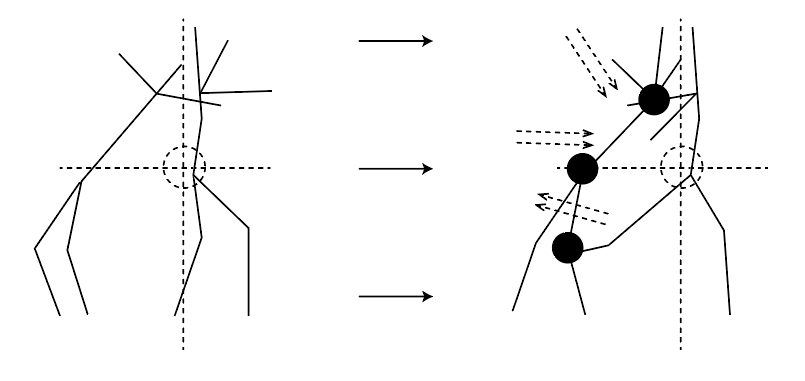NODUS LABS / Discourse Reconfiguration Using Network Analysis / Case Study
∞OS principles can be used for changing configuration and balance of power in any relational structure. In this case study we will look into an example of a discoursive text network — or a dispositif. We will demonstrate how the framework of networks can be used to represent the inherent tensions present within a system. We will then show how ∞OS procedures can be applied to those points of tension in order to change the structure of the system or shift it towards a new state. We will be using physical movement metaphors at every step of this demonstration in order to give practical and tangible application examples.
Discoursive Text Network
Any text can be represented as a network. Every word is a node and every co-occurrence of words is the connection between them. This procedure uses a well-known methodology based, in particular, on text network analysis and landscape reading model. The result of this representation is a graph of nodes and edges, an example of which you can see on the image below:

This graph was created using InfraNodus text-to-network conversion tool and further visualized with Gephi. The data used to create this graph are the excepts from a book on Rhetorics. We took the parts we personally found the most interesting and added them into InfraNodus. This tool connects different bits and pieces of text together using the procedure outlined above, resulting in a graph representation of text.
So far we have this text represented as a graph, but it is not aligned, so it doesn’t make too much sense. As the next step we apply a certain layout algorithm to this graph, which:
1) Identifies the nodes with the highest “betweenness centrality” — words that appear most often between different topics present inside the text and makes them bigger on the graph.
2) Those nodes are then increased in size and are pushed apart from each other.
3) The smaller nodes (words), which are connected to those more central nodes, are pulled towards them.

Therefore, each node in the graph experiences simultaneous push and pull, which is applied through an iterative algorithm, bringing the graph to a more readable shape above. On this image we can directly see where the points of tension are located inside the graph: those are identified with the green squares. If we wanted to reconfigure this network or bring it towards a new state we could apply external impulses to those green areas.
Destabilization = Constructive Challenge
Here we are following the destabilization / reconfiguration procedure of ∞OS as described below:
Applied to the text network structure this ∞OS procedure would start from identifying those points of tension a bit more precisely in order to know what they consist of. We use InfraNodus tool to do that. First, we focus on the node “relationship” in order to see which context it appears in:

As we can see it points to the part of the text, which is talking about the facts that words (signifiers) should not be taken for granted. The relationship between the sign and the signifier is arbitrary and the meaning that it produces is based on a convention (a social arrangement to use this particular signifier to point to a particular concept).
In terms of ∞OS this sentence is quite central to the quotes that we selected from the book because it connects different topics that are present in this collection of quotes together. It’s like we identified an important structural tension knot in the body of text.
If we now wanted to destabilize this discourse, we would need to identify another tension point in this discourse, following the ∞OS destabilization procedure.

We would then apply a successive array of impulses to those points.
A way to do that in the context of working with a text is to identify another point of “tension” (crossroads of meaning) and to then ask a question that would link these two together. It is important to note that destabilization here does not mean necessarily that our intention is to destroy the discourse. Rather, we want to challenge it. A challenge is something that can be very constructive, especially when it elicits the kind of response that helps to evolve the structural and dynamic properties of the discourse.

Here we take the point on the graph, which is the furthest geodesic distance from the first point (as the resulting challenge will be the highest here). Here the text is talking about a metaphor and how it produces meaning through what is called the “tenor” (which is the topic or the original subject — e.g. in the sentence “The girl is a snake” the “girl” is the tenor) and the vehicle (the analogy or association that is used to bring a different context to the original — “the snake”).
We can then ask ourselves: what would be the relation between the mechanism of the sign and the signifier and the way that metaphor operates? It’s a challenging question for this text because there is not yet any connection that brings those two points together. So we are compelled to find a solution or to think how those two could be related. A physical metaphor for this is that we temporarily lose the balance in order to find the new equilibrium.
For instance, it could be that the relation between the tenor and the vehicle is somewhat similar as between the sign and the signifier and therefore if we bring the arbitrary nature of the second we can see how the process of meaning formation in metaphor is a more specific case of the meaning formation that occurs between the sign and the signifier. The latter operates through convention, while the metaphor brings in something that is more related to the collective subconscious. “This girl is a snake” — both “snake” and the “girl” are the signifiers for the two different concepts, but this metaphor brings those two together. It’s like it operates on the meta-level and produces the new meanings through making connections that were not evident before through analogy and association.




